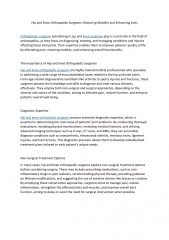Occupational Therapy Guidelines for Adults Undergoing Total Hip Replacement
This practice guideline from the Royal College of Occupational Therapists focuses on occupational therapy intervention for adults undergoing total hip replacement. It outlines evidence-based recommendations to maximize functional independence, reduce anxiety, support role resumption, prevent readmissions, decrease hospital stay length, lower support service demand, and facilitate community reintegration. The guideline's key objective is to provide appropriate care for occupational therapists working with such patients, addressing intervention throughout the care pathway in any setting.
Download Presentation

Please find below an Image/Link to download the presentation.
The content on the website is provided AS IS for your information and personal use only. It may not be sold, licensed, or shared on other websites without obtaining consent from the author.If you encounter any issues during the download, it is possible that the publisher has removed the file from their server.
You are allowed to download the files provided on this website for personal or commercial use, subject to the condition that they are used lawfully. All files are the property of their respective owners.
The content on the website is provided AS IS for your information and personal use only. It may not be sold, licensed, or shared on other websites without obtaining consent from the author.
E N D
Presentation Transcript
Occupational therapy for adults undergoing total hip replacement Practice guideline Royal College of Occupational Therapists Specialist Section - Trauma and Orthopaedics www.RCOT.co.uk
Learning outcomes To explore aspects of the practice guideline recommendations in relation to current practice. To develop an understanding of the importance of using practice guidelines to inform practice. To explore and develop an understanding of how to use the RCOT Audit Form for use with the evidence-based recommendations. 2 www.RCOT.co.uk
Practice question: What evidence is there to support occupational therapy intervention with adults over the age of 18 undergoing total hip replacement? 3 www.RCOT.co.uk
Key objective of guideline To describe the most appropriate care or action to be taken by occupational therapists working with adults undergoing total hip replacement. It addresses occupational therapy intervention during the service user s journey along the care pathway and is applicable to any setting. 4 www.RCOT.co.uk
Methodology 2. Guideline scope defined involving stakeholders 1. Guideline development group established 4. Screen findings 3. Literature search 5. Critically appraise articles 7. Peer review, stakeholder and service user consultation 6. Development of practice guideline recommendations 8. Final draft approved by COT Practice Publications Group 9. Published by COT 2012 5 www.RCOT.co.uk
Evidence-based recommendations Recommendations are based on the evidence available within 54 critically appraised papers. Each recommendation is assigned: A strength scoring 1 or 2 (Strong or Conditional); A quality grading A, B, C or D (High, Moderate, Low or Very Low). 6 www.RCOT.co.uk
Recommendation areas Maximised functional independence; Reduced anxiety; Resumption of roles; Low readmission rates; Decreased length of hospital stay; Reduced demand on support services; Reintegration into the community. 7 www.RCOT.co.uk
Maximised functional independence Maximised functional independence 1. It is recommended that the occupational therapy assessment is comprehensive and considers factors which may affect individual needs, goals, recovery and rehabilitation, including co-morbidities, trauma history, personal circumstances, obesity and pre-operative function. (Johansson et al 2010, C; Lin and Kaplan 2004, C; Marks 2008, C; Naylor et al 2008, C; Ostendorf et al 2004, C; Vincent et al 2007, C; Wang et al 2010, C) 1 C 2. It is recommended that goal setting is individualised, enhances realistic expectations of functional independence, and commences at pre- operative assessment. (Judge et al 2011, C; Mancuso et al 2003, C) 1 C 8 www.RCOT.co.uk
Maximised functional independence contd. Maximised functional independence 3. It is recommended that occupational therapists ensure that they provide clear communication and advice that is consistent with that of other members of the multidisciplinary team. (Fielden et al 2003, C) 1 C 4. It is recommended that depression and anxiety status are taken into account during pre-operative and post-operative intervention due to their potential for impact on recovery. (Caracciolo and Giaqunito 2005, C; Nickinson et al 2009, C) 1 C 5. It is recommended that cognitive status is taken into account during pre- operative and post-operative intervention due to its potential for impact on recovery. (Wang and Emery 2002, C; Wong et al 2002, C) 1 C 9 www.RCOT.co.uk
Maximised functional independence contd. Maximised functional independence 6. It is recommended that service users are fully involved in decisions about the equipment required to enable them to carry out daily living activities and to comply with any hip precautions in their home environment post-surgery. (Thomas et al 2010, D) 7. It is recommended that service users are given advice on effective pain management strategies, to decrease pre-operative pain experience and sleep disturbance, and enhance post-operative physical function. (Berge et al 2004, B; Montin et al 2007, C; Parsons et al 2009, C) 1 D 1 B 8. It is suggested that standardised assessment and outcome measures are used, where appropriate, to determine functional outcomes and occupational performance in rehabilitation settings, either inpatient or community based. (Gillen et al 2007, C; Kiefer and Emery 2004, C; Oberg et al 2005, D) 2 C 10 www.RCOT.co.uk
Reduced anxiety Reduced anxiety 1 A 9. It is recommended that the pre-operative assessment undertaken by the occupational therapist allows adequate time for individualised questions and discussion of expectations and anxieties. (Fielden et al 2003, C; McDonald et al 2004, A; Montin et al 2007, C) 2 C 10. It is suggested that occupational therapists offer support and advice to service users who may be anxious about an accelerated discharge home. (Heine et al 2004, D; Hunt et al 2009, D; Montin et al 2007, C) 11. It is recommended that pre-operative assessment and education is carried out in the most appropriate environment for the service user. For the majority of service users a clinic environment is appropriate, but where needs are complex, a home assessment should be an available option. (Crowe and Henderson 2003, B; Drummond et al 2012, C; Orpen and Harris 2010, C; Rivard et al 2003, B) 1 B 11 www.RCOT.co.uk
Reduced anxiety contd. Reduced anxiety 2 C 12. It is suggested that provision of equipment pre-operatively may facilitate familiarity and confidence in use. (Fielden et al 2003, C; Orpen and Harris 2010, C) 2 C 13. It is suggested that service users may value being treated by the same occupational therapist throughout the process, from pre-operative assessment/education to post-operative rehabilitation wherever possible. (Spalding 2003, C) 14. It is suggested that occupational therapists should contribute to standardised pre-operative education interventions, providing information, advice and demonstrations where relevant (e.g. of joint protection principles, equipment, etc.). (Coudeyre et al 2007, B; Johansson et al 2007, B; Spalding 2003, C; Spalding 2004, C; Soever et al 2010, C) 2 B 12 www.RCOT.co.uk
Resumption of roles Resumption of roles 1 C 15. It is recommended that work roles are discussed at the earliest opportunity as part of a comprehensive assessment. (Bohm 2010, C; Mobasheri et al 2006, D; Nunley et al 2011, C) 2 C 16. It is suggested that for service users who are working, advice is provided relating to maintaining their work role pre-operatively, post- operative expectations and relevant information for employers. (Bohm 2010, C; Mobasheri et al 2006, D; Nunley et al 2011, C; Parsons et al 2009, D) 17. It is recommended that occupational therapists provide advice to facilitate service users to establish previous and new roles and relationships, and shift their focus from disability to ability. (Grant et al 2009, C) 1 C 13 www.RCOT.co.uk
Low readmission rates Low readmission rates 1 B 18. It is recommended that occupational therapists consult with the surgical team regarding any specific precautions to be followed post-operatively. (Hol et al 2010, B; Peak et al 2005, B; Restrepo et al 2011, B; Stewart and McMillan 2011, C; Ververeli et al 2009, B) 1 B 19. It is recommended that occupational therapists advise service users, where protocol includes precautions, on appropriate position behaviours for those daily activities applicable to the individual's needs, ranging from getting in/out of a car to answering the telephone. (Drummond et al 2012, C; Malik et al 2002, D; Peak et al 2005, B; Stewart and McMillan 2011, C; Ververeli et al 2009, B) 20. It is suggested that due to the uncertainty surrounding the need for hip precautions, and the potential for an increase in satisfaction and early functional independence when hip precautions are relaxed or discontinued, occupational therapists engage in local discussion/review of the emerging evidence with their surgical and multidisciplinary teams. (Drummond et al 2012, C; O Donnell et al 2006, D; Peak et al 2005, B; Restrepo et al 2011, B; Ververeli et al 2009, B) 2 B 14 www.RCOT.co.uk
Decreased length of hospital stay Decreased length of hospital stay 1 B 21. It is recommended that occupational therapists optimise length of stay, with due reference to care pathways and enhanced recovery programme guidance. (Berend et al 2004, C; Bottros et al 2010, C; Brunenberg et al 2005, C; Husted et al 2008, C; Kim et al 2003, B) 1 A 22. It is recommended that the occupational therapist is involved in early multidisciplinary post-operative intervention for service users following hip replacement, providing either inpatient or home-based rehabilitation. (Iyengar et al 2007, C; Khan et al 2008, A; Siggeirsdottir et al 2005, C) 15 www.RCOT.co.uk
Reduce demand on support services Reduce demand on support services 2 C 23. It is suggested that there are potential benefits in including informal carers in pre-operative assessment/education, and post-operative intervention, to maximise service user independence and reduce carer stress. (Chow 2001, C) 16 www.RCOT.co.uk
Reintegration into the community Reintegration into the community 1 C 24. It is recommended that occupational therapists encourage early discussion and goal setting for community reintegration, including social and physical activities. (de Groot et al 2008, D; Gillen et al 2007, C) 2 C 25. It is suggested that where specific needs are identified, the occupational therapist refers the service user on to community rehabilitation, reablement or intermediate care services to enhance community reintegration. (de Groot et al 2008, D; Gillen et al 2007, C) 17 www.RCOT.co.uk
Impact of practice guideline for you: the practitioner Challenges / affirms your current practice. Provides evidence-based recommendations to inform and support your practice. Raises awareness of benefits and risks and organisational and financial barriers. Provides a vehicle for you to audit and justify your practice. 18 www.RCOT.co.uk
Impact of practice guideline for managers Provides evidence of the need for occupational therapy input into services for adults undergoing total hip replacement. Provides a structure to audit the work of occupational therapists within the service to improve service quality. Provides a vehicle for justifying service provision. 19 www.RCOT.co.uk
Impact of practice guideline for commissioners Articulates the need for occupational therapy interventions within services for adults undergoing total hip replacement. Provides recommendations developed by a NICE Accredited process. Can help educate commissioners to identify learning needs for the workforce. Audit form provides a mechanism to review service delivery in accordance with the evidence. 20 www.RCOT.co.uk
Impact of practice guideline for service users The recommendations reinforce the fundamental importance of the service user perspective. In being adopted by services and occupational therapists, the guideline should improve the consistency and quality of intervention for users of services. Gives assurance that practitioners use the available evidence to support interventions. 21 www.RCOT.co.uk
Service user perspectives This is a common and routine operation so sometimes you feel all the pre-operative assessment is a tick box - but to you it is a major event and very worrying. The home visit by my local OT was extremely helpful. He explained very clearly what I might expect and ways of helping my recovery and improving my post-op mobility. It is vitally important that your relatives and carers are involved in pre- operative education. It is really important that you are given consistent advice from everyone in the team - you can be told different things by different people and this increases your fears and worries both before and after the operation. 22
Practice guideline resources College of Occupational Therapists (2012) Occupational therapy for adults undergoing total hip replacement: practice guideline. London: COT. Audit tool. Quick Reference Guide. Feedback form. Resources are available from the Royal College s website at: https://www.rcot.co.uk/practice-resources/rcot- practice-guidelines 23 www.RCOT.co.uk






















